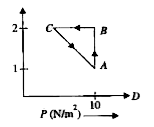In changing the state of a gas adiabatically from an equilibrium state A to another equilibrium state B an amount of work equal to 22.3 J is done on the system.If the gas is taken from state A to B via a process in which the net heat absorbed by the system is 9.35 cal then the net work done by the system in latter case is
(Take 1 case =4.2 J)
15 J
16 J
17 J
18 J
The correct Answer is:C
To solve the problem, we will follow these steps:
Step 1: Understand the Given Information
We are given:
- Work done on the system during an adiabatic process from state A to B, Wadiabatic=−22.3J (negative because work is done on the system).
- Heat absorbed by the system in a different process from A to B, Q=9.35cal.
Step 2: Convert Heat from Calories to Joules
We need to convert the heat absorbed from calories to joules using the conversion factor 1cal=4.2J:
Q=9.35cal×4.2Jcal=39.27J
Step 3: Determine the Change in Internal Energy
In the adiabatic process, the change in internal energy ΔU is equal to the negative of the work done on the system:
ΔU=−Wadiabatic=−(−22.3J)=22.3J
Step 4: Apply the First Law of Thermodynamics
According to the first law of thermodynamics:
ΔQ=ΔU+W
We can rearrange this to find the work done in the latter process:
W=ΔQ−ΔU
Step 5: Substitute the Values
Now we can substitute the values we have:
W=39.27J−22.3J
W=16.97J
Step 6: Round the Result
Rounding 16.97 J gives us approximately:
W≈17J
Final Answer
The net work done by the system in the latter case is approximately 17 J.
---
We are given:
- Work done on the system during an adiabatic process from state A to B, Wadiabatic=−22.3J (negative because work is done on the system).
- Heat absorbed by the system in a different process from A to B, Q=9.35cal.
We need to convert the heat absorbed from calories to joules using the conversion factor 1cal=4.2J:
Q=9.35cal×4.2Jcal=39.27J
In the adiabatic process, the change in internal energy ΔU is equal to the negative of the work done on the system:
ΔU=−Wadiabatic=−(−22.3J)=22.3J
According to the first law of thermodynamics:
ΔQ=ΔU+W
We can rearrange this to find the work done in the latter process:
W=ΔQ−ΔU
Now we can substitute the values we have:
W=39.27J−22.3J
W=16.97J
Rounding 16.97 J gives us approximately:
W≈17J
The net work done by the system in the latter case is approximately 17 J.
Topper's Solved these Questions
- THERMODYNAMICSBOOK - NCERT FINGERTPS ENGLISHCHAPTER - THERMODYNAMICSEXERCISE - HOTs
8 Videos
- THERMODYNAMICSBOOK - NCERT FINGERTPS ENGLISHCHAPTER - THERMODYNAMICSEXERCISE - Assertion & Reason
15 Videos
- THERMAL PROPERTIES OF MATTERBOOK - NCERT FINGERTPS ENGLISHCHAPTER - THERMAL PROPERTIES OF MATTEREXERCISE - Assertion And Reason
10 Videos
- UNITS AND MEASUREMENTSBOOK - NCERT FINGERTPS ENGLISHCHAPTER - UNITS AND MEASUREMENTSEXERCISE - Assertion And Reason
15 Videos
Similar Questions
In changing the state of a gas adiabatically from an equilibrium state A to another equilibrium state B, an amount of work equal to 22.3 J is done on the system. If the gas is taken from state A to B, via a process in which the net heat absorbed by the system is 9.35 cal, how much is the net work done by the system in the latter case ?
View SolutionIn changing the state of a gas adiabatically from an equilibrium state A to another equilibrium state B, an amount of work equal to 22.3J is done on the system. If the gas is taken from State A to B via a process in which the net heat absorbed by the system is 9.35cal., How much is the net work done by the system in the later case? (Take 1cal.=4.9J)
View Solution
Knowledge Check
When the state of a gas adiabatically changed from an equilibrium state A to another equilibrium state B an amount of work done on the stystem is 35 J. If the gas is taken from state A to B via process in which the net heat absorbed by the system is 12 cal, then the net work done by the system is (1 cal = 4.19 J)
Aa. 13.2JBb. 15.4 JCc. 12.6 JDd. 16.8 JAn ideal gas is taken through cycle A→B→C−A, as shown in Fig. IF the net heat supplied to the gas in the cycle is 5 J, the work done by the gas in the process C→A is
 A−5JB−10JC−15JD−20J
A−5JB−10JC−15JD−20J
When a system is in equilibrium state
View SolutionIn an isobaric process, the ratio of heat supplied to the system (dQ) and work done by the system (dW) for diatomic gas is
View SolutionA system absorbs 300 cal of heat. The work done by the system is 200 cal. ΔU for the above change is
View SolutionFor a gaseous system find change in internal energy if the heat supplied to the system is 50 J and work done by the system is 16 J.
View SolutionFor a gaseous system find change in internal energy if the heat supplied to the system is 50 J and work done by the system is 16 J.
View SolutionThe internal enegy of an ideal gas decreases by the same amount as the work done by the system.
View Solution